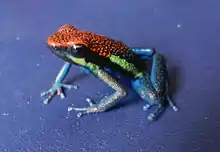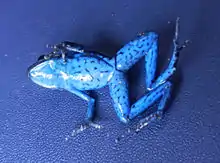Manú poison frog
The Manú poison frog (Ameerega macero) is a frog species in the family Dendrobatidae[2][3] found in southern Peru[3] and Brazil.[1] It can be found in the drainages of the Manú, Urubamba, Upper Purus and Ucayali Rivers. It can also be found in Serra do Divisor National Park and Alto Juruá Extractive Reserve.
| Manú poison frog | |
|---|---|
 | |
| Scientific classification | |
| Domain: | Eukaryota |
| Kingdom: | Animalia |
| Phylum: | Chordata |
| Class: | Amphibia |
| Order: | Anura |
| Family: | Dendrobatidae |
| Genus: | Ameerega |
| Species: | A. macero |
| Binomial name | |
| Ameerega macero (Rodríguez & Myers, 1993) | |
| Synonyms | |
|
Epipedobates macero Rodríguez & Myers, 1993 | |
Its natural habitats are lowland tropical moist forests and montane forests, in particular bamboo forests, at elevations of 150–1,450 m. It is threatened by habitat loss due to agriculture, and is illegally harvested for the pet trade.[1]

Dorsal view of a captive individual

Ventral view of a captive individual
References
- IUCN SSC Amphibian Specialist Group (2014). "Ameerega macero". IUCN Red List of Threatened Species. 2014: e.T55226A43517282. doi:10.2305/IUCN.UK.2014-1.RLTS.T55226A43517282.en. Retrieved 17 November 2021.
- Grant, T.; Frost, D. R.; Caldwell, J. P.; Gagliardo, R.; Haddad, C. F. B.; Kok, P. J. R.; Means, D. B.; Noonan, B. P.; Schargel, W. E. & Wheeler, W. C. (2006). "Phylogenetic systematics of dart-poison frogs and their relatives (Amphibia: Athesphatanura: Dendrobatidae)" (PDF). Bulletin of the American Museum of Natural History. American Museum of Natural History. 299: 1–262. doi:10.1206/0003-0090(2006)299[1:PSODFA]2.0.CO;2. S2CID 82263880.
- Frost, Darrel R. (2014). "Ameerega macero (Rodriguez and Myers, 1993)". Amphibian Species of the World: an Online Reference. Version 6.0. American Museum of Natural History. Retrieved 7 July 2014.
This article is issued from Wikipedia. The text is licensed under Creative Commons - Attribution - Sharealike. Additional terms may apply for the media files.
